As an Amazon Associate I earn from qualifying purchases.
Beer battered halibut fish and chips are a necessary part of human existence, and I am here to help you perfect this classic.
At some point, all of us have sat face-to-face with a pile of English fish and chips or fried clams. As this usually happens first when we are tiny tots, the experience can alter the course of our dietary existence: After that virginal fish fry, many of us we emerge either as committed fish lovers — or, like many Americans, committed fish haters.
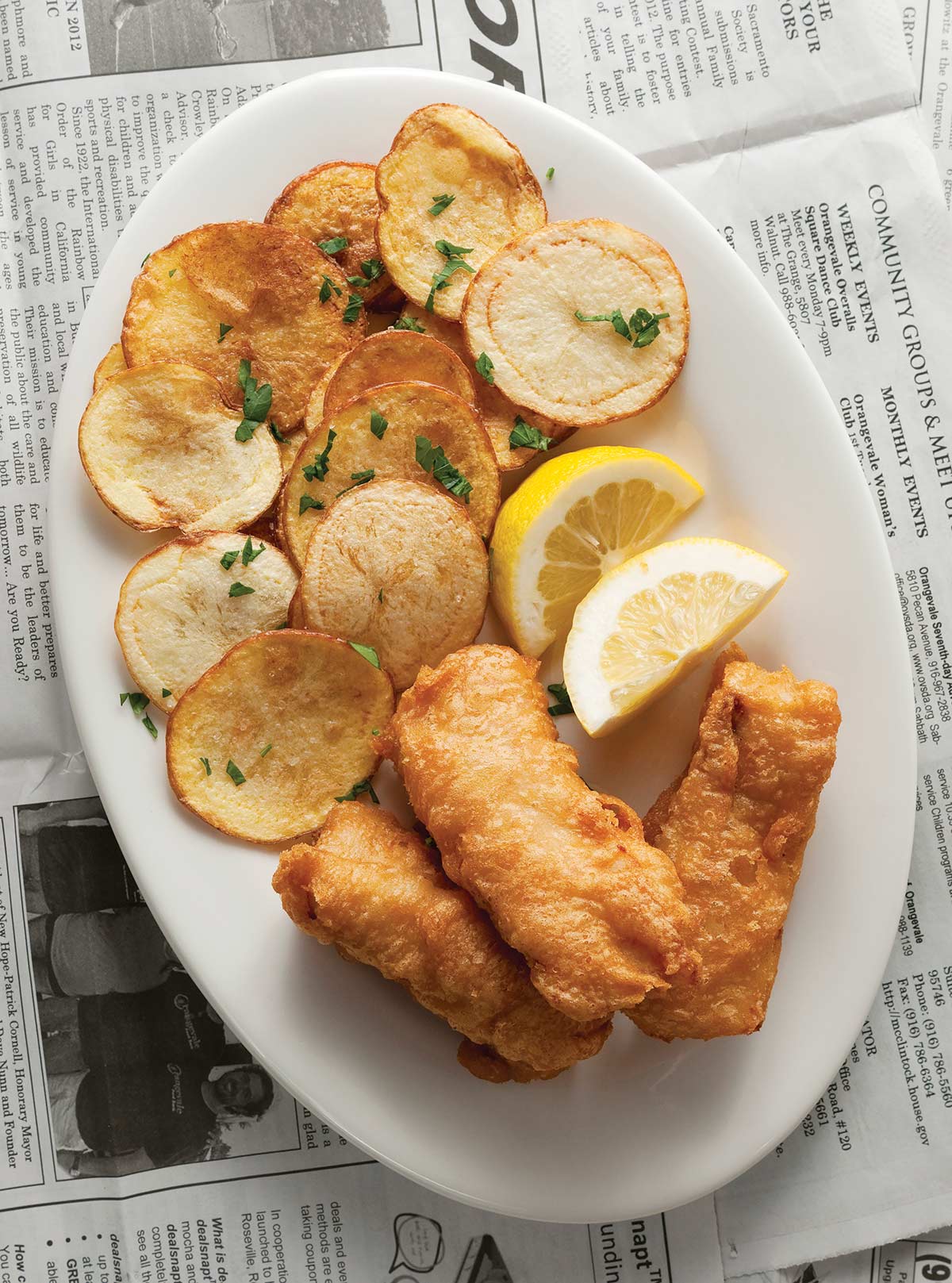
Only about half of Americans eat seafood more than once or twice a year, and I suspect that a big reason for such a gulf between fish eaters and fish haters is what was on that first plate of beer battered fish and chips. Try to think back to your childhood now: Did your mom cook her own fried fish, or did she open a box and shake out a few frozen fish sticks?
I have vivid memories of both cases. My mom cooked her own fish. I have a crystalline image in my head of mom busily making fried flounder. It must have been the mid-1970s. She’s standing next to a pile of flounder fillets, each layer separated by paper towels sodden with oil. We’d eat these with lemon and lots of “tah-ta sauce.” Mom is from Massachusetts.
I also remember eating at some of my friends’ houses. That image is of pre-breaded fish sticks clunking out onto a foil-lined tray that somebody else’s mother popped into the oven, often a toaster oven. I remember these being dreadful.
But neither of these are halibut fish and chips, or really any beer battered fish. These, for most of us, are only eaten at restaurants. Here’s how to make them at home. Correctly.
English fish and chips may be that nation’s culinary gift to the rest of the world, although the English are experts at roasting large pieces of meat, too. Let’s start with the fish.

Best Fish for Fish and Chips
I’ve eaten beer battered fish and chips six ways to Sunday, but all the best share a few characteristics: They’re all firm, white, and lean — and of course skinless and boneless. My go-to here at home is halibut fish and chips.
Cod, haddock and pollock are classics in the East, as is halibut, rockfish or lingcod in the West. In Wisconsin and Minnesota, walleye and yellow perch are king. In the South, it’s all catfish until you get to the Gulf, where snapper and redfish take over. Hell, I’ve even used tilapia.
Dogfish and leopard shark are the perfect frying fish, and in fact are traditional with northern English fish and chips. The meat is white as snow, very lean, and firmer even than halibut. And, happily none of these fish are threatened, so you can eat them with a clean conscience.
Bottom line: You want a reasonably thick, firm fish for the best beer battered fish and chips. Avoid soft textured fish like mackerel or bluefish, or really thin fish like flounder; they are best cooked a little differently.
Seafood? You bet. Beer battered shrimp and lobster is amazing. Obviously you can batter clams, as many do, and I suppose you could batter squid, too, although it’s usually just floured and fried.
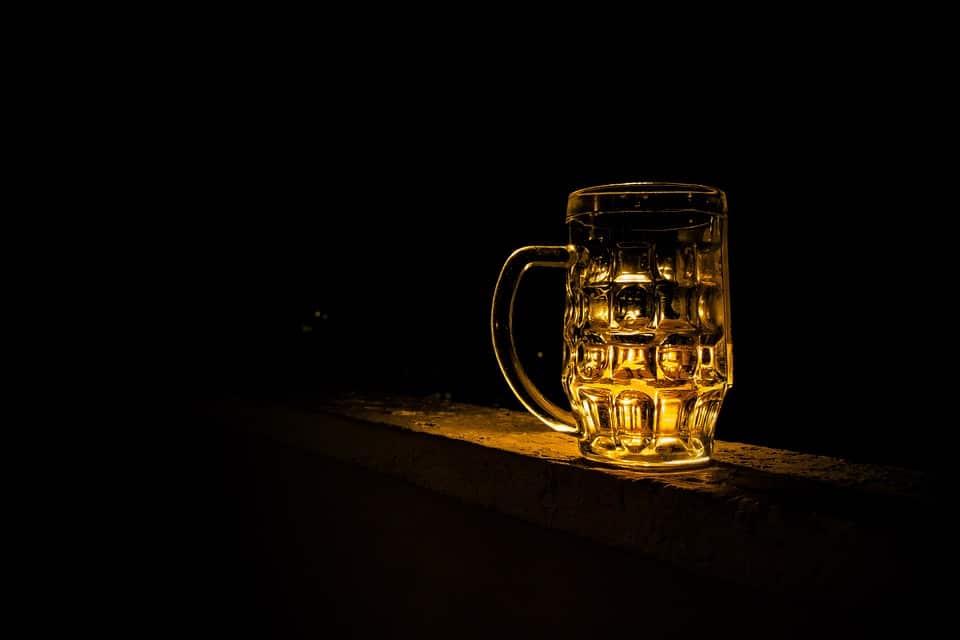
Best Beer for Fish and Chips
Take a tip from the origin of the dish. Halibut fish and chips is best with English beer. A mild, malty beer is my absolute favorite. It is distinctive enough to get you noticed among beer battered fish aficionados, and won’t ruin your batter like an IPA. Never use IPAs for beer battered fish and chips. The bitterness will wreck the dish.
Other than that, the sky’s the limit, although my next favorites after the English ales are German (really American and Mexican) lagers. Avoid a really good pilsner since it too will be hoppy in its own way. Cheap American macro beers are great for beer batter.
And while they have their adherents, “weird” beers like sours or heavy Belgian beers or oddly flavored beers might end up as your favorite, but it won’t please a crowd.
Oh, and what’s with the beer anyway? Beer’s carbonation makes a lighter batter. This is another reason why you want to avoid sours or IPAs, which are not normally heavily carbonated. Lagers are typically the most carbonated beers you will normally buy.
The Flour
You can absolutely go minimalist and use plain flour for halibut fish and chips. Many do. But you will get a better batter if you use self-rising flour, or just add a bit of baking powder to your regular flour.
Want to play? Play with the flour. Different flours will give you different results. Most, however, will be heavier than all-purpose flour. I rarely deviate from the ole’ AP flour.
You can add whatever seasonings you want to the flour, but I generally keep things very simple because any spices or whatever you add will be exposed to the raging hot oil and can burn and become bitter. Paprika is especially prone to this.
I don’t cook gluten-free on purpose, but here is a pretty legit gluten-free beer batter for fish if you can’t do flour. Not as good as the real thing, but hey, better than nothing!
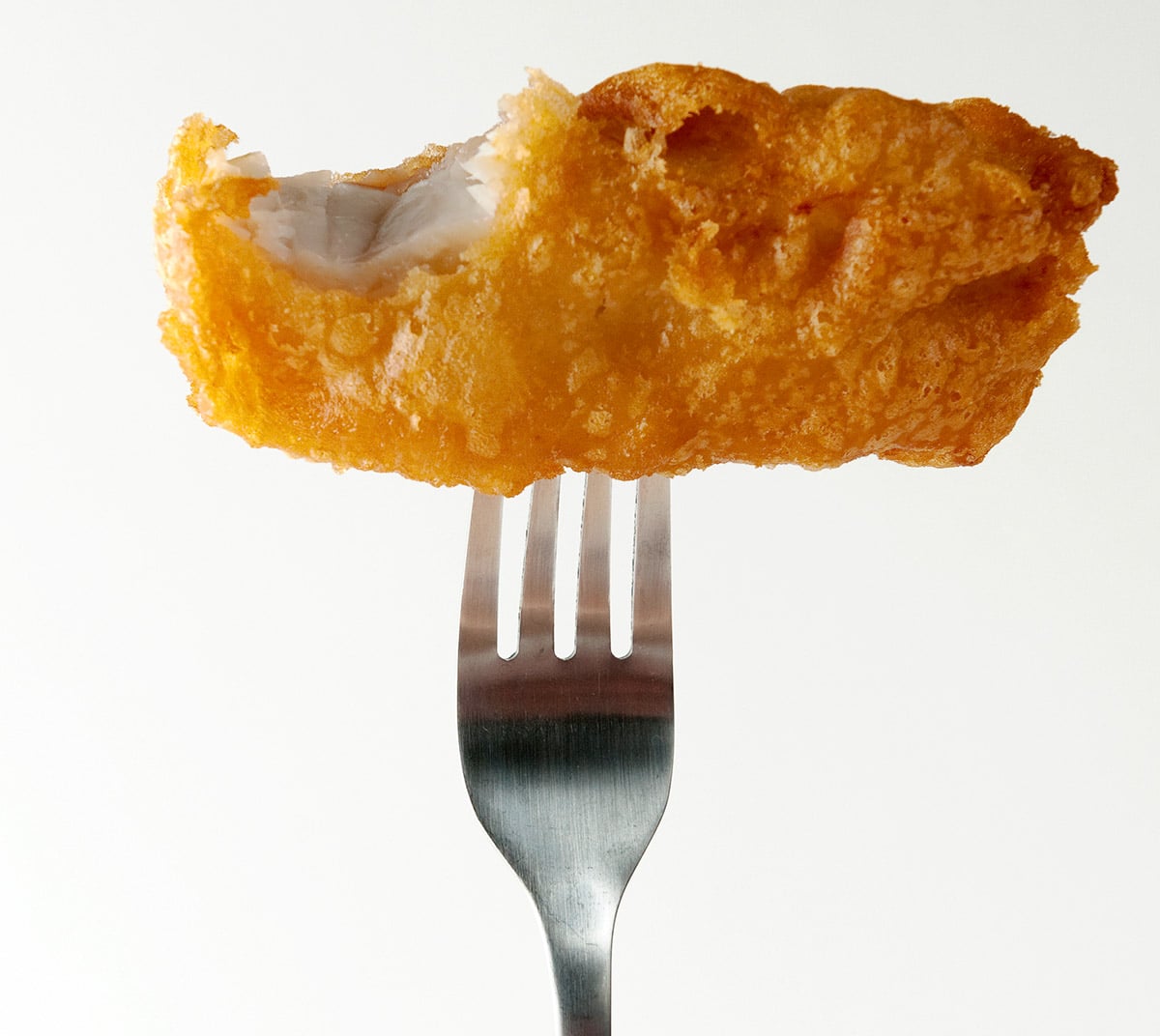
Achieving The Crisp
We eat halibut fish and chips because we want that juxtaposition of perfectly cooked, essentially steamed fish, inside a crispy, crispy exterior.
You get that with hot oil. I know this seems obvious, but I need to stress this. People get scared of hot oil, and if you are, beer battered fish and chips are not for you. You need the oil at at least 350°F and really 360°F. Good oils like refined peanut oil, canola, corn oil, grapeseed and avocado can all handle this easily.
Hell, regular vegetable oil will, too, although you will then want to watch that the oil doesn’t climb above 400°F at any moment. Not a problem in most cases.
Yeah, it can be sporty to have a half-gallon of 360°F oil roiling on your stovetop, but so long as you know it’s that hot, you’re fine. Bad things happen when you don’t, and the oil gets too hot. Thermometers are a must.
I like deep fryers because they restrict the amount of vaporized grease that gets into the air. And while that aroma really adds to the ambiance of a place like Pike Street Fish Fry, its not so good in your house. But a heavy Dutch oven will work fine, too. Just keep the oven fan on high.
Oil temperature isn’t the only factor in ultra crispy halibut fish and chips. How you hold the finished pieces matters a lot, too. Remember me talking about Mom frying fish and stacking them like cordwood? Don’t do that.
(Like this recipe? I have lots of variations on fried fish here, from Chinese salt and pepper fish, to Mexican fried fish, to a simple fried snapper with Saltines.)
Instead, place a cooling rack on a baking sheet in the oven and set it to “warm,” or about 185°F. Set the finished pieces on the rack and they will stay crispy.
Overloaded fryers also cause soggy fish and chips. Place each battered piece in the hot oil separately, and make sure you wait a second — or have enough room — for the batter to set or so that the pieces never touch in the first 30 seconds or so. After that, they can bounce around if they want.
I know, so many words about halibut fish and chips. But even though this is a simple recipe, it is technique driven, and there is a reason that the best fish and chips places are revered.
Side note: When eaten cold the next day, halibut fish and chips (or those made with little sharks) tastes astonishingly like cold fried chicken. Go figure.
The Chips
A word on the chips: I am not very good at making my own French fries, which require double-frying. Here is a good recipe for the French Fries.
Instead I make my own chips, which I like just as much. Potatoes sliced just thick enough so the center is soft, just thin enough that a quick bath in hot oil will crisp the outsides.
You make these before the fish, actually, because they take longer and hold well in the oven. Pro tip: Use waxy potatoes like Yukon Golds, not russets. The texture is more like a fried potato and less like a store-bought potato chip.
Beer Battered Halibut Fish and Chips
Ingredients
FISH
- 2 pounds fish, skinless and boneless
- Salt
- Oil for frying
- About 1/2 bottle beer
- 1 teaspoon salt
- 1/2 cup self-rising flour
CRISPS
- 2 pounds Yukon gold potatoes, sliced into 1/8-inch thick rounds
- 2 tablespoons vegetable oil
Instructions
- Salt the fish and set it aside at room temperature. Get your oil going: You want it to be 350°f to about 360°F. Turn the oven to the "warm" setting, and put a cookie sheet inside. Place a cooling rack on top of the cookie sheet.
- Mix the flour, salt and beer together, stirring all the while. You want enough beer in the batter to give it the consistency of house paint, or melted ice cream. Put the batter in the fridge to rest for 20 minutes.
- While the batter is resting, slice the potatoes and put them into a large bowl of cold water. When you are done slicing, remove the potatoes and pat them dry with a paper towel.
- The oil should be hot by now. Fry the potatoes, a few at time, for 3 to 5 minutes, or until they start to brown at the edges. Don't cook them until they are uniformly brown or you will overcook them; they will continue to brown a little out of the fryer. Salt each batch the moment it comes out of the fryer. Store each batch on the wire rack in the warm oven.
- When the potatoes are done, take the batter out of the fridge. Dredge the fish in the batter and let the excess drip off for a second or two. Lay each piece gently into the hot oil. Do this by letting the bottom end of the piece of fish fry for a second or so in the oil before you let the whole piece get a bath. This helps prevent the fish from sticking to the bottom of the pot. Keep a chopstick or something similar around to dislodge any pieces that do get stuck.
- Fry in batches until golden brown, about 5 to 8 minutes depending on how large the pieces are. Keep each batch in the warm oven while you finish the rest. Serve at once when you're done.
Video
Notes
Keys to Success
- Keep the fish in manageable pieces, no bigger than your palm.
- Make sure the oil is hot, 350°F or a little hotter, and the batter is cold. This shock makes a lighter batter.
- When in doubt, make the batter thicker.
- Keep seasoning simple. If you want jazz, do that with the sauce.
Nutrition
Nutrition information is automatically calculated, so should only be used as an approximation.
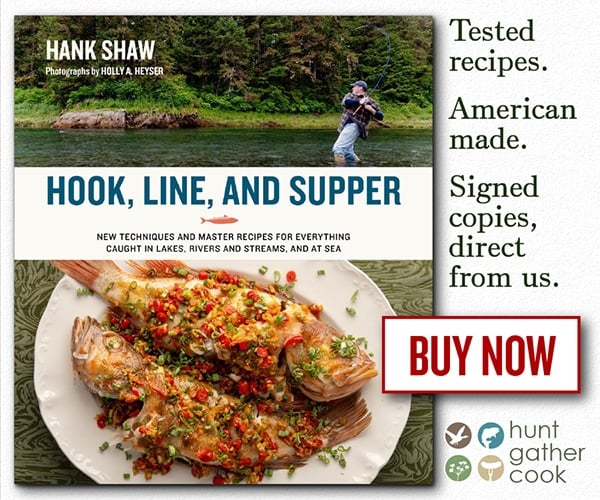


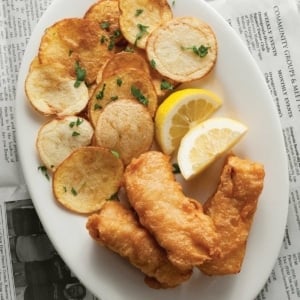
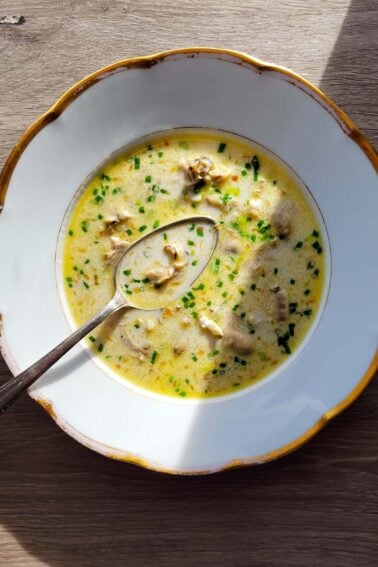

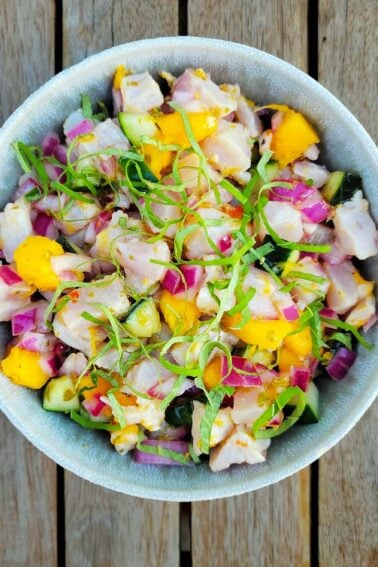
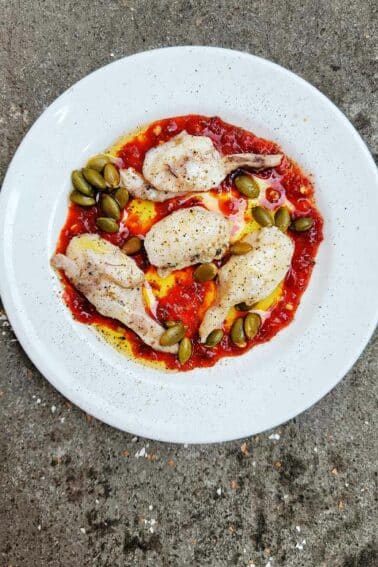
Perfect recipe all around… I’m cooking lingcod and rockfish caught off Simpson reef out of coos bay oregon, and this time I’m using corona familiar for the batter… the darker the beer the better the batter! And completely optional dust the chips with zaterans garlic and herb flavor it’s the perfect amount of crunch on the soft chips… once prepared match your meal with a twelve pack of pacifico and enjoy
Hank,
I’m about to fry some beautiful Pollack fillets using your recipe. I am using Shock Top (an unfitered belgian wheat beer with a “citrusy” finish). I’ll let ya know how it comes out.. Looking forward to the outcome ?
Simple recipe and exponentially better than other more complex ones I have tried. Thanks Hank for the best of the rest. I’ve tried many of your recipes and they’ve all exceeded my previous attempts
Caught a few Columbia River Sturgeon this year, just fried up some. We borrowed some seasoned panko breading from an award winning fish & chips restaurant in Seattle, and put that up against this basic beer-batter. And guess what, the beer batter won unanimously! Really complemented the fish. Now its just time to mess around with different beers! (We started with Rainier)
I just made this with the first fish I ever caught as an adult (a bream/bluegill). Absolutely the freshest, most delicious fish I have ever had and the chips were pretty good, too! I am hooked! No pun intended! 🙂
This is just delicious! Easy, quick, yummy, what’s not to like?!
Hi Hank. I’ve caught dogfish my entire life and just thrown them back. How do you prepare dogfish?
Matt: When they come over the side, kill and gut immediately, then put on ice. Fillet as normal, skin and cut into pieces you’d like to fry. Done this way, they’re awesome.
You should come up to eastern Canada, or even New England to learn how to make/cook fish & chips. Properly done, both the fish and the chips should be twice cooked. To do both in one fry is definitely not normal. Hard or burnt chips and fish. love your blog, just have a problem with this recipe. camp cooking! Cheers.
Frank: I know perfectly well how to make fish and chips and the fish certainly does not need double frying. If you actually ate these you’d see. I am sure you can make fish and chips just fine, but there are many many ways to get a great result. This is one of them.
Made this yesterday with sea bream. The family loved it! I also added 1 Egg and powderd garlic. Thx!
Keep up the excellent work on this site. I am a regular “lurker” 🙂
mahi mahi makes great fish and chips. For the chips I make fries. We like the fries much better.
I deep fry outside with a propane burner, same one we use for frying turkeys,canning etc. I love fried potatoes but with my southern roots have to say hushpuppies are my favorite with fried fish. Cook them in the same oil soon as the fish is done and draining. Like my mom made just cornmeal, salt, and boiling water. Going to try your batter recipe thanks Hank
This is sooo good!! In the batter I added an egg, a pinch of garlic pepper, and seasoned salt, which gave it a better flavor and texture. 10/10 would recommend!
Woow, never eat shark until now.
For frying fish, I usually use instant multi-purpose seasoning flour. It is very good for making fried chicken,fish, prawn, squid, tofu, etc. Crispy and savory, no need to add egg and spices anymore.
Yeah,it is suit for lazy boy like me.
Dave: Fries with gravy is not really a uniquely Newfoundland thing, as you can pretty much get gravy for your fries anywhere in Canada.
However, Newfoundlanders are about the only people who put stuffing and gravy on top of fries.
Intrigued….
@Hank: Checked this evening and the the temp is off by 30 degrees F (low) according to Thermapen (need to do final check with Thermapen and boiling water). I’ve had it for several years and used it (only once every few months) with no problems, but the last two times I’ve used it have been bad. I guess I’ll have to see if I can recalibrate it or maybe just switch to the dutch oven.
Joe: I reuse it. Here’s how: Once the oil is cool, I set a strainer over a 4-cup measuring cup. I then set a paper towel in the strainer and pour the oil through. This filters out a lot of the debris. The oil is actually better the second or third time you use it. I keep mine for about 5 uses before tossing it.
JW Hammer: Weird. Gotta be a temperature thing with the potatoes. That happens. As for the batter not sticking, I suspect that’s because the fish was too wet before you dipped it. I make sure my pieces of fish are pretty dry before dunking. As for the fryer, I’ve never had a problem with mine, so maybe you got a bum model?
My potatoes came out soggy and my batter didn’t stick. Do you think that is oil temp related? I have different model of the same deep fryer you use, but my last batch of fries was soggy too and I’m wondering whether the thermostat is busted. Should have checked the oil temp with my Thermapen. Based on how seldom I deep fry, what a hassle the thing is to keep clean, and now suspicions of poor performance… whether a deep fryer with an accurate thermometer is really an upgrade to oil in a dutch oven.
What do you do with the leftover oil? Are you able to keep it for any length of time?
I’ve made a number of trips to Newfoundland, and enjoyed the fish and chips at “Ches’s Fish and Chips” enormously. The thing that Newfoundland adds to the Fish and Chip standard is brown gravy! They pour that stuff all over the chips and on the fish too. I prefer it on the side so I can dip gently, but it’s an amazing thing.
Hank, if you grew up in Westfield like your sister you may have had F&C at the Chippery in Fanwood. It turns out their F&C were amazing, and ranked up with the best Newfoundland could provide (and vastly superior to any I’ve had in London, UK, which is now a sad and ugly F&C wasteland).
I get around the pain in the butt aspect of doing good fries
by nuking the taters with the skins on, then allow them to cool,
sometimes over night in the fridge if I’m not in a hurry.
The nuker tends to dry them out a bit, a good thing if you like
crispy fries. There’s usually enough moisture left so that the
potatoes will congeal enough for slicing once they have cooled.
P.S.
Enjoyed your book.